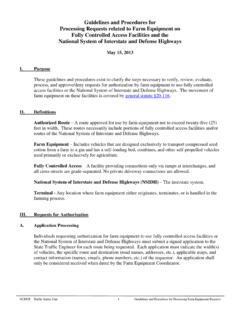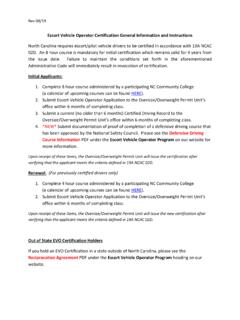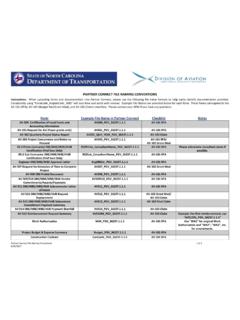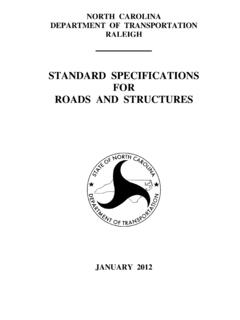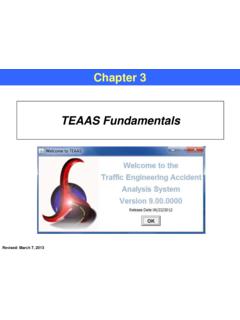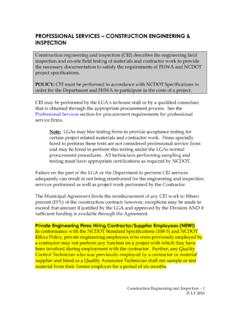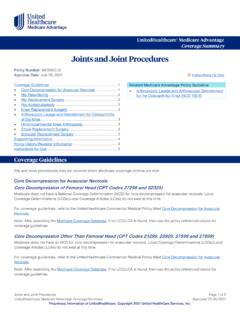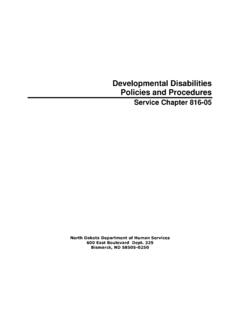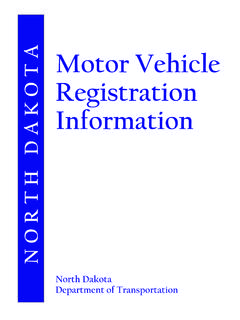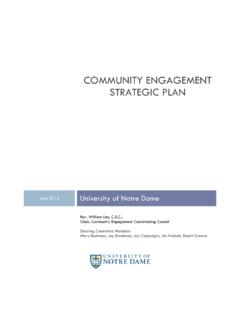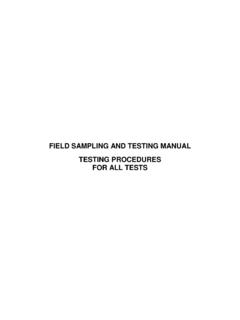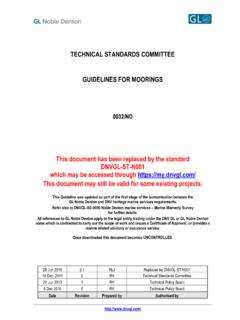Transcription of UAS STANDARD OPERATING PROCEDURES - NCDOT
1 UAS STANDARD OPERATING PROCEDURES FLIGHT OPERATIONS UAS PROGRAM OFFICE NORTH CAROLINA DEPARTMENT OF TRANSPORTATION 1050 Meridian Drive, Morrisville, NC, 27560 UAS STANDARD OPERATING PROCEDURES 1 NCDOT Division of Aviation - (919) 814-0550 CONTENTS 1. INTRODUCTION ..2 2. PERSONNEL ..3 UAS Coordinator: .. 3 Remote Pilot-in-command (rPIC): .. 3 Observers (Optional) .. 4 3. TRAINING ..5 Training Plans .. 5 Initial Training .. 5 Recurrent Training .. 6 4. PRE-FLIGHT OPERATIONS ..7 Planning .. 7 Inspection .. 7 Weather .. 8 Checklist .. 8 Documentation .. 10 5. DURING FLIGHT 12 6. POST FLIGHT OPERATIONS .. 13 7. EMERGENCY 14 8. FLIGHT AREA / PERIMETER MANAGEMENT .. 16 9. ACCIDENT REPORTING .. 17 10. FLIGHT CREW COMMUNICATI O N S .. 19 11. EXTERNAL COMMUNICATIONS .. 20 12. REFERENCES .. 21 UAS STANDARD OPERATING PROCEDURES 2 NCDOT Division of Aviation - (919) 814-0550 1.
2 INTRODUCTION The STANDARD operational PROCEDURES will serve as a guide for flight operations planning and execution. The operational PROCEDURES document best practices and internal processes for safe and effective flight operations. This includes roles and responsibilities, mission phases, and emergency PROCEDURES . The aim is to document everything that needs to be done during a mission, so it can act as a reference point for team members. Flight operations should be conducted under the 14 CFR Part 107/Certificate of Airworthiness. However, not all of these guidelines will apply to all situations. Therefore, use your best judgment and error to the side of safety. UAS STANDARD OPERATING PROCEDURES 3 NCDOT Division of Aviation - (919) 814-0550 2. PERSONNEL The UAS Coordinator or Remote Pilot-in-command (RPIC) is responsible for the overall safety during UAS operations.
3 UAS COORDINATOR: The UAS Coordinator shall maintain a file for each operator and airframe. The file shall include copies of training records, flight incidents, maintenance records, etc. It is the responsibility of the UAS Coordinator to be current and to update the RPIC and observer with all federal and state regulations as they change; The UAS Coordinator shall ensure that the RPIC has all documents required as per FAA, state and department guidelines. The UAS Coordinator should ensure that the RPIC is current with the training and knowledge. It is the responsibility of the UAS Coordinator to ensure all UAS are registered and in airworthy condition. REMOTE PILOT-IN-COMMAND (RPIC): To be considered for selection as an operator, applicants must meet the requirements for and successfully pass the FAA Remote Pilot Certification and the North Carolina UAS Operator permit administered by NC Division of Aviation in order to be accepted into the UAS crew.
4 Operators interacting with Air Traffic Control (ATC) or Terminal Radar Approach Control Facilities (TRACON) shall have sufficient expertise to perform that task readily. Operators must have an understanding of, and comply with FAA Regulations applicable to the airspace where the UAS operates. An operator's primary duty is the safe and effective operation of the UAS in accordance with the manufacturers' approved flight manual, FAA regulations, NC General Statues and department policy and PROCEDURES . Operators must remain knowledgeable of all FAA regulations; UAS manufacturer's flight manual and bulletins and department policy and PROCEDURES . Operators may be temporarily removed from flight status at any time by the UAS Coordinator, for reasons including performance, proficiency, physical condition, etc. Should this become UAS STANDARD OPERATING PROCEDURES 4 NCDOT Division of Aviation - (919) 814-0550 necessary, the operator will be notified verbally and in writing of the reason, further action to be taken and expected duration of such removal.
5 It is the responsibility of the RPIC to ensure all UAS are registered and in airworthy condition prior to UAS operations. OBSERVERS (OPTIONAL) Observers must have been provided with sufficient training to communicate clearly to the operator any turning instructions required to stay clear of conflicting traffic and obstacles. An observer's primary duty is to operate the UAS's equipment including cameras, radio communications with RPIC , as well as be an observer for anything that may affect the RPICs primary duty (see and avoid). UAS STANDARD OPERATING PROCEDURES 5 NCDOT Division of Aviation - (919) 814-0550 3. TRAINING The key to continued safe operations is by maintaining a professional level of competency. The first step in this process is establishing minimum qualifications for selecting operators, and the second step involves training those personnel. TRAINING PLANS 1.
6 All operators have a training plan on file that outlines training objectives. This training plan will be held in conjunction with the member's normal training file per department policy. 2. The approved training plan is developed by the UAS coordinator. 3. All deployments or exercises are documented and count toward an operators training. 4. It is the UAS Coordinators/ RPIC responsibility to verify the training file contains all pertinent information. INITIAL TRAINING 1. Operators must obtain the FAA Remote Pilot Certification and the North Carolina UAS Operator Permit . In addition the operator should, at a minimum, have knowledge of the rules and responsibilities described in 14 CFR , OPERATING Near Other Aircraft; 14 CFR , Right-of -Way Rules: Except Water Operations; and 14 CFR , Basic VFR Weather Minimums; knowledge of air traffic and radio communications, including the use of approved ATC/pilot phraseology; and knowledge of appropriate sections of the Aeronautical Information Manual.
7 2. In conjunction with fulfilling all training requirements for RPICs duties, the new operator must also become familiar with UAS operations, the aircraft and its equipment. 3. Any new operator who fails to successfully complete the initial training may be denied as a PIC of the UAS operation. 4. Before an operator can fly as RPIC, he/she must complete at least two hours of flight training with the department assigned UAS Coordinator to show proficiency of the flight training exercises and the airframe. This must be accomplished to show their ability and knowledge of the UAS. UAS STANDARD OPERATING PROCEDURES 6 NCDOT Division of Aviation - (919) 814-0550 RECURRENT TRAINING 1. All operators shall maintain proficiency in their RPIC abilities. Operators who do not have any documented training or flight time within a span of 60 days will have to show proficiency before being a RPIC during an UAS operation or exercise.
8 2. Recurrent training is not limited to actual OPERATING skills but includes knowledge of all pertinent UAS/aviation matters. 3. Failure to prove proficiency can result in removal from UAS responsibilities. UAS STANDARD OPERATING PROCEDURES 7 NCDOT Division of Aviation - (919) 814-0550 4. PRE-FLIGHT OPERATIONS Preflight activities are the duty of the RPIC before the start of the flight operation. Activities include inspection of the aircraft, assessment of the OPERATING location, briefing crew members involved in the operation, and equipment checkouts. All flight operations should be conducted in accordance with the provision of 14 CFR Part 107, state and local regulations, and the operator s manual for the subject aircraft. PLANNING 1. The flight crew should be familiarized with all available information pertaining to the flight such as; take-off/landing, including but not limited to the operational limitations of Part 107, weather conditions, hazards, no fly zones, etc.
9 2. North Carolina state statues require land-owner approval before operations take place. 3. RPIC will ensure the location for take-off and emergency landing is adequate upon arrival at the location. At least one emergency landing area should be identified before the start of operations. 4. RPIC should be aware of all surroundings in the event that an emergency landing is necessary. This includes the ability to recover the UAS. INSPECTION 1. Before the first flight of the day, verify all batteries are fully charged. 2. Check the airframe for signs of damage, and its overall condition. 3. Check the entire aircraft per the pre-flight inspection instructions in the manual for the specific aircraft to make sure it is in good structural condition and no parts are damaged, loose, or missing. 4. Check the propeller or rotor blades for chips, cracks, looseness and any deformation.
10 5. Check that camera(s) and mounting systems are secure and operational. 6. Perform an overall visual check of the aircraft prior to arming any power systems. 7. Repair or replace any part found to be unsuitable to fly during the pre-flight PROCEDURES prior to takeoff. UAS STANDARD OPERATING PROCEDURES 8 NCDOT Division of Aviation - (919) 814-0550 WEATHER 1. Before each flight the RPIC and observer should ensure that he/she gathers enough information about the existing and anticipated near-term weather conditions throughout the entire mission environment. As a best practice he/she should utilize FAA approved weather resources such as; Meteorological Terminal Aviation Weather Reports (METARS), Terminal Area Forecasts (TAF), etc. to obtain the best information. In order to obtain the latest and most current weather conditions, Notices to Airmen (NOTAMs), and Temporary Flight Restrictions (TFRs) the RPIC should obtain a local aviation briefing at; 1-800-WXBRIEF or 2.
